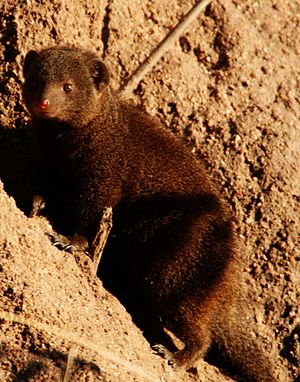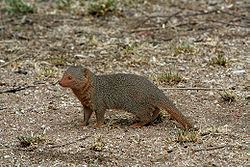- Common Dwarf Mongoose
-
Common Dwarf Mongoose 
Conservation status Scientific classification Kingdom: Animalia Phylum: Chordata Class: Mammalia Order: Carnivora Family: Herpestidae Subfamily: Herpestinae Genus: Helogale Species: H. parvula Binomial name Helogale parvula
Sundevall, 1847
Common Dwarf Mongoose range The Common Dwarf Mongoose (Helogale parvula), sometimes just called the Dwarf Mongoose, is a small African carnivore belonging to the mongoose family (Herpestidae).
Contents
Physical characteristics
The Common Dwarf Mongoose is a typical mongoose: it has a large pointed head, small ears, a long tail, short limbs, and long claws. The species can be distinguished from other mongooses by its size. It is much smaller than most other species (18 to 28 cm, 210 to 350 grams); in fact, it is Africa's smallest Carnivore. The soft fur is very variable in color, ranging from yellowish red to very dark brown.
Distribution and habitat
The Common Dwarf Mongoose is primarily found in dry grassland, open forests, and bush land, up to 2,000 meters in altitude. It is especially common in areas with many termite mounds, their favorite sleeping place. The species avoids dense forests and deserts. The Common Dwarf Mongoose can also be found in the surroundings of settlements, and can become quite tame.
The species ranges from East to southern Central Africa, from Eritrea and Ethiopia to the Transvaal in South Africa.
Behavior
The Common Dwarf Mongoose is a diurnal animal. It is a highly social species that lives in extended family groups of two to thirty animals. There is a strict hierarchy among same-sexed animals within a group, headed by the dominant pair (normally the oldest group members). All group members cooperate in helping to rear the pups and guarding the group from predators.
Young mongooses attain sexual maturity by one year of age but they delay dispersal, with males usually emigrating (in the company of their brothers) at 2-3 years old. Dispersing males may join other established groups (either as subordinates or by ousting the resident males) or they may found new groups with unrelated dispersing females. In contrast, females normally remain in their home group for life, queuing for the dominant position. They do, however, emigrate (to found a new group) if they lose their place in the hierarchy to a younger sister. Sometimes the dominant male.....
Dwarf mongooses are territorial, and each group uses an area of approximately 30-60 hectares (depending on the type of habitat). They sleep at night in disused termite mounds, although they occasionally use piles of stones, hollow trees, etc. The mongooses mark their territory with anal gland and cheek gland secretions and latrines. Territories often overlap slightly, which can lead to confrontations between different groups, with the largest group tending to win.
Dwarf mongooses tend to breed during the wet season, between October and April, raising up to three litters. Generally only the group's dominant female becomes pregnant and she is responsible for 80% of the pups reared by the group. If conditions are good, subordinate females may also become pregnant but their pups rarely survive. After the gestation period of 53 days, 4-6 young mongooses are born. They remain below ground (within a termite mound) for the first 2-3 weeks. Normally one or more members of the group stay behind to babysit while the group goes foraging. Subordinate females often produce milk to feed the dominant female's pups. At 4 weeks of age the pups begin accompanying the group. All group members help to provided them with prey items until they are around 10 weeks old.
A mutualistic relationship has evolved between Dwarf Mongooses and hornbills, in which hornbills seek out mongooses in order for the two species to forage together and warn each other of nearby birds of prey and other predators.[2]
Diet
The diet of the Common Dwarf Mongoose consists of insects (mainly beetle larvae, termites, grasshoppers and crickets), spiders, scorpions, small lizards,snakes, small birds, and rodents, and is supplemented very occasionally with berries.
References
- ^ Creel, S. & Hoffmann, M. (2008). Helogale parvula. In: IUCN 2008. IUCN Red List of Threatened Species. Downloaded on 22 March 2009. Database entry includes a brief justification of why this species is of least concern
- ^ Anne O, Rasa E (1983). "Dwarf mongoose and hornbill mutualism in the Taru desert, Kenya." Behavioral Ecology and Sociobiology 12 (3): 181–90.
Categories:- IUCN Red List least concern species
- Mongooses
- Mammals of Africa
Wikimedia Foundation. 2010.



